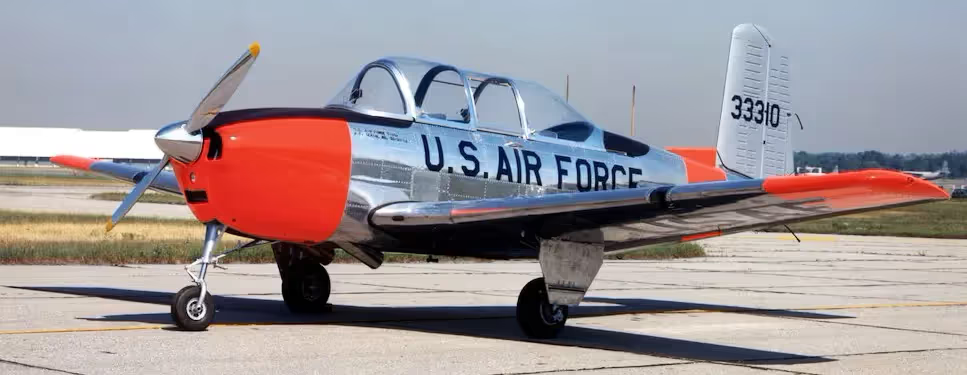Canadian Warplanes 5: Canadian Car and Foundry (Beechcraft) T-34 Mentor
Canadian Car and Foundry (Beechcraft) T-34A Mentor

(LynnGarrison9281 Photo)
Canadian Car and Foundry (Beechcraft Model 45), T-34 Mentor, RCAF (Serial No. 24205), over RCAF Station Penhold, Alberta, 12 Aug 1954. RCAF Course Nos. 5409 and 5411 flew the T-34 as experimental replacement for the Harvard, 1954.
The Beechcraft T-34 Mentor is an American propeller-driven, single-engined, military trainer aircraft derived from the Beechcraft Model 35 Bonanza. The earlier versions of the T-34, dating from around the late 1940s to the 1950s, were piston-engined. These were eventually succeeded by the upgraded T-34C Turbo-Mentor, powered by a turboprop engine. The T-34 remains in service more than seven decades after it was first designed.
Canadian Car and Foundry (Beechcraft) T-34 Mentor (25), (Serial Nos. 24201-24225). Fort William, Ontario CCF c/ns CCF34‑4 to CCF34‑28.
Mentors served with the RCAF in the mid 50's, including briefly at Penhold, Alberta. One crashed while in RCAF service, the remaining 24 were given to Turkey.
Canadian Car and Foundry (Beechcraft Model 45), T-34 Mentor, RCAF (Serial No. 24220) operated by No. 4 Flying Training School at RCAF Station Penhold, Alberta, was lost on 2 Dec 1954 when both wings failed while the pilot was carrying out aerobatic maneuvres. It struck the ground seven miles south of Eckville Corners, Alberta and was destroyed. 22-year-old Flying instructor 105382 Flying Officer Darrel Arthur Thomas Hurley from Westmount, Quebec was killed. (Chris Charland)
From the VAC accident summary: "The instructor was conducting an authorized instructional flight when he advised the student pilot that he (the instructor) was going to do a manoeuvre consisting of a loop, rolls, and a second loop. The instructor asked the student pilot if he had ever blacked out. The student pilot told the instructor he had never blacked out. The instructor then told the student pilot that he intended to pull-up sharply from the dive after the second loop.
The instructor then began the manoeuvre previously described. During the pull-up from the second dive, the aircraft was apparently overstressed and the wings failed. The student pilot managed to bail-out at an altitude of about 3,000 feet. The aircraft crashed and burned at approximately 1430 Mountain Standard Time (MST). The instructor was unable to bail-out and was killed in the crash. The investigation found that although the student pilot had parachuted to safety, his parachute had gotten fouled with the tail section when he exited the aircraft and a section of the canopy had been ripped from top to bottom." (Christopher Shelley)

(USAF Photo)
Beech T-34A Mentor at the National Museum of the United States Air Force.

(RCAF Photo)
CCF Mentor (Serial No. 24201).

(RCAF Photo)
CCF Mentor, (Serial No. 24211).





